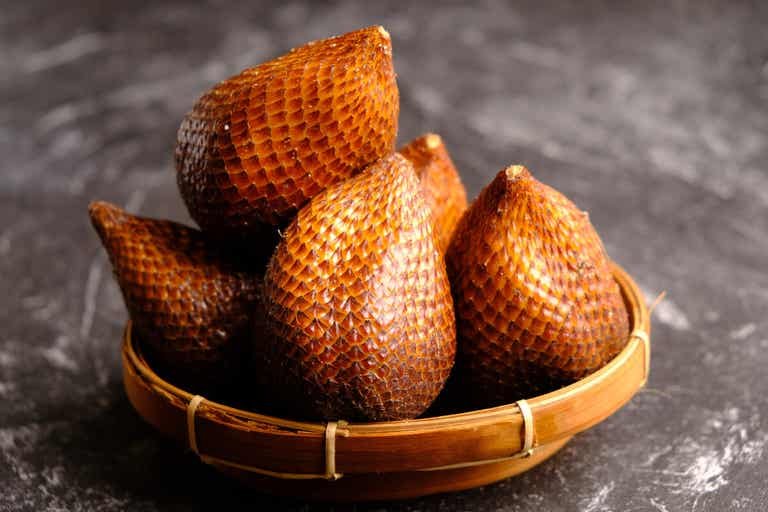 Image 1 of 2
Image 1 of 2

 Image 2 of 2
Image 2 of 2

Snake fruit (Salak Bali)
Snake fruit also called salacca zalacca or Salak, originated in Indonesia but is now produced all around southeast Asia. The fruit encased in a red/brown scales, sometimes covered with spikes reminding of reptile. The skin is actually quite thin and can be easily peeled off by breaking the tip. The fruit pulp look similar to large peeled cloves of garlic. The seeds inside are inedible.
Thanks to its minerals and active nutrients -such as thiamine (helps to turn food into energy to keep the nervous system healthy), iron, calcium, vitamin C potassium, beta-carotene and pectin, this fruit is able to increase blood flow to the brain, which can boost cognition, improve your memory power and low your risk of neurodegenerative diseases: One of the nicknames of salak is “Memory Fruit”. It also helps eliminating oxidative stress.
Snake fruit also called salacca zalacca or Salak, originated in Indonesia but is now produced all around southeast Asia. The fruit encased in a red/brown scales, sometimes covered with spikes reminding of reptile. The skin is actually quite thin and can be easily peeled off by breaking the tip. The fruit pulp look similar to large peeled cloves of garlic. The seeds inside are inedible.
Thanks to its minerals and active nutrients -such as thiamine (helps to turn food into energy to keep the nervous system healthy), iron, calcium, vitamin C potassium, beta-carotene and pectin, this fruit is able to increase blood flow to the brain, which can boost cognition, improve your memory power and low your risk of neurodegenerative diseases: One of the nicknames of salak is “Memory Fruit”. It also helps eliminating oxidative stress.
Snake fruit also called salacca zalacca or Salak, originated in Indonesia but is now produced all around southeast Asia. The fruit encased in a red/brown scales, sometimes covered with spikes reminding of reptile. The skin is actually quite thin and can be easily peeled off by breaking the tip. The fruit pulp look similar to large peeled cloves of garlic. The seeds inside are inedible.
Thanks to its minerals and active nutrients -such as thiamine (helps to turn food into energy to keep the nervous system healthy), iron, calcium, vitamin C potassium, beta-carotene and pectin, this fruit is able to increase blood flow to the brain, which can boost cognition, improve your memory power and low your risk of neurodegenerative diseases: One of the nicknames of salak is “Memory Fruit”. It also helps eliminating oxidative stress.

Informations
The complex tropical flavor of Snake fruit is often described as a blend of apple, pineapple and banana. It has the sweetness of honey with an acidic finish, leaving a citrusy tingle on the tongue and leaning more sweet or sour depending on the variety.
All varieties are succulent but depending on the tannin’ levels, some fruits are drier with a flaky texture, while others are more spongy.
Each fruit weighs around 90g and can be eaten raw, juiced, pickled or candied in syrup.
